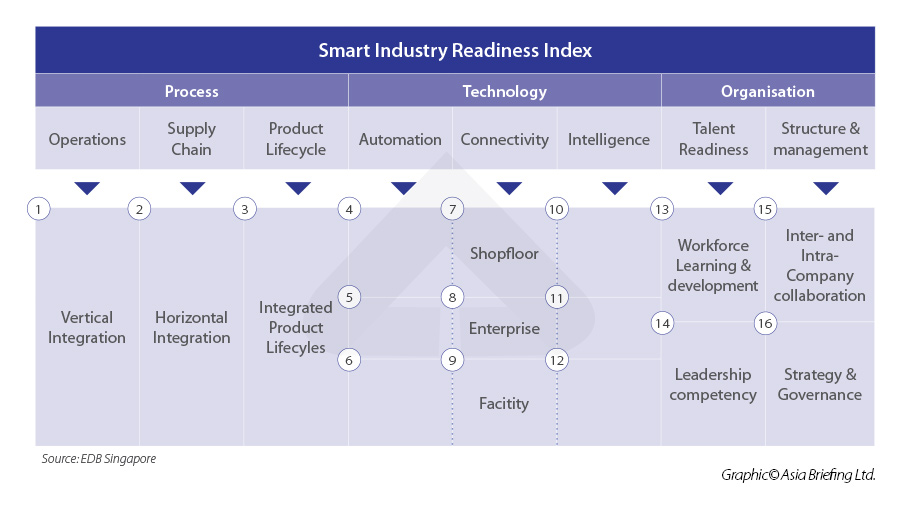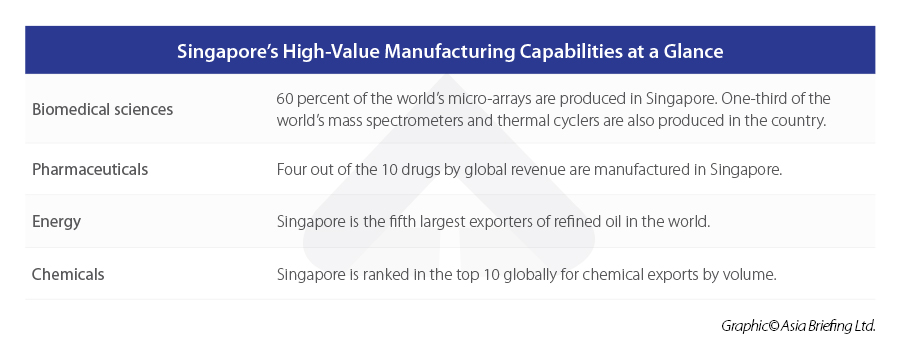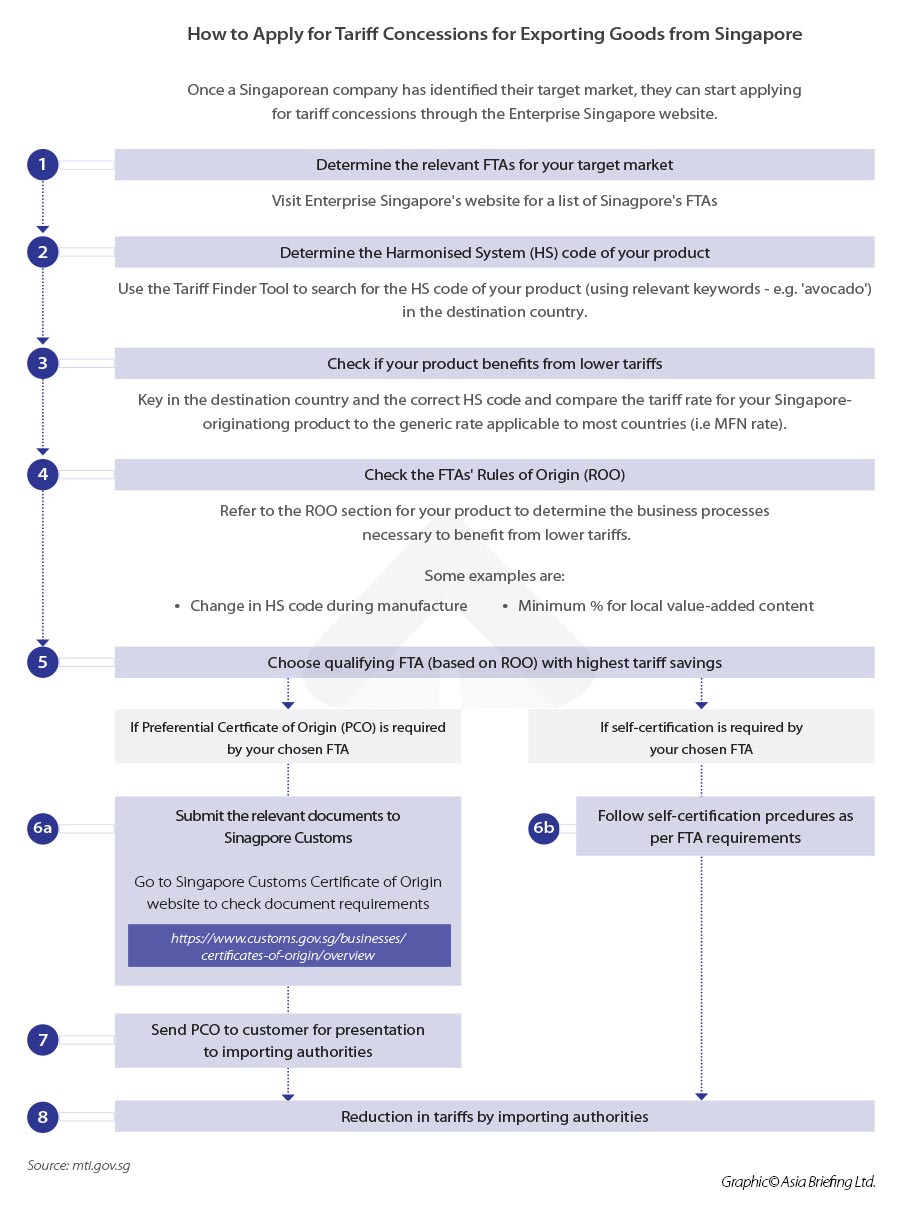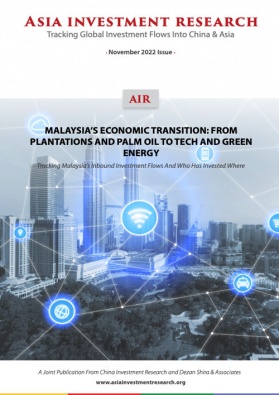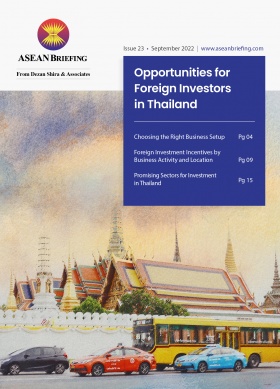How Singapore is Poised to Take Advantage of Industry 4.0
Singapore’s manufacturing sector is well-positioned to face the challenges and reap the benefits of Industry 4.0. As an established regional powerhouse for advanced manufacturing, the country has already embraced Industry 4.0 and is steadily moving its production base up the value chain.
The Fourth Industrial Revolution is already upon us and presents challenges and changes to businesses worldwide. With its robust manufacturing ecosystem, high-skilled talent base, and government support for businesses doing research and innovation, Singapore is well-positioned to take lead in the transition to Industry 4.0.
The country is home to a vibrant start-up scene, which offers opportunities for co-innovation with large multinational companies (MNCs). By some estimates, Singapore is used as a regional headquarter by more than 37,000 international companies and 7,000 MNCs.
More than ever, Singapore’s importance as a base for Industry 4.0 can help foreign businesses reduce investment risk, maximize profit, and harness business opportunities in the region. We explore in greater detail as to why Singapore is ready to take advantage of Industry 4.0.
The Singapore Smart Industry Readiness Index
In 2017, Singapore launched the Smart Industry Readiness Index (SIRI), the world’s first Industry 4.0 tool that helps manufacturers — regardless of their size — to start, scale, and sustain their manufacturing operations. SIRI was developed together by the Singapore Economic Development Board (EDB), leading technology companies, industry and academic experts, and consultancy firms.
SIRI educates manufacturers on the concept of Industry 4.0 and how to develop in-depth understanding of a company’s Industry 4.0 maturity level. Following this, SIRI can recommend the company’s ideal business objectives and activities that can bring them the greatest benefits in the Industry 4.0 era.
The SIRI index consists of three layers. The top layer is made up of three building blocks: process, technology, and organization. Under the building blocks are eight pillars of focus, which are then divided into 16 dimensions of assessment. Companies can use this to evaluate their readiness for Industry 4.0.
A world-class manufacturing ecosystem
Manufacturing accounts for approximately 20 percent of Singapore’s GDP and is an important cornerstone for the economy as well as the country’s competitiveness in Industry 4.0. Over the past few decades, the country has achieved growth capacity in high-value manufacturing, engineering, and innovation. Singapore is now an industry leader in various sectors, such as semiconductor manufacturing, pharmaceutical products, medical products, and aerospace engineering and has attracted MNCs like Siemens, Schneider Electric, Accenture, HSBC, IBM, Shell, UOB, and GlaxoSmithKline to set up here.
Supporting Singapore’s manufacturing ecosystem are investments in research and development (R&D) within the engineering and advanced manufacturing fields. For example, the National Robotics Program helps engineers and scientists translate their research into reality and is driving robotics adoption in Singapore’s manufacturing sector.
Over the next five years, the country plans to spend over S$25 billion (US$17.6 billion) for R&D in a continuing effort to build a more resilient and sustainable Singapore. One-fifth of the funds is allocated for innovation platforms, developing entrepreneurial talent, and supporting business innovation capabilities. The remainder is set aside for new programs that support future needs and emerging opportunities as well as talent development.
Further, built within the country’s universities and research centers are model factories that stimulate real-life production environments for the testing of new manufacturing techniques, technologies, and business models that can be exported from Singapore to the rest of the world.
A highly skilled workforce
Singapore has a highly skilled workforce, ranked second globally in the 2021 Global Talent Competitiveness Index. The country’s bilingual education policy means students are proficient in English (first in Asia for English proficiency) and one other language, such as Mandarin, Malay, or Tamil. Further, the school curriculum has a strong focus on science, technology, engineering, and math subjects.
Singapore’s higher education institutions have established with leading MNCs to develop corporate labs that develop cutting edge solutions for real Industry 4.0 challenges, such as cybersecurity, computational engineering, blockchain, artificial intelligence, and smart industrial chemical production.
The 2021 Global Talent Competitiveness Index also highlights that Singapore has one of the best pools for vocational and technical skills that matches labor market demands. More than 30 percent of the workforce holds a university degree with another 15 percent holding a diploma or professional qualification.
Further, the government launched an initiative called SkillsFuture in 2015. The initiative is a national movement that aims to provide Singaporeans opportunities to develop their fullest potential in life regardless of their starting point. The government provides the resources to help citizens attain a mastery of skills. SkillsFuture includes short training
programs, online tutorials, and earn-and-learn industry internships.
The four key focus areas under the initiative are:
- Helping individuals make well-informed choices in training, education, and careers.
- Developing an integrated and high-quality education and training system that responds to industry needs.
- Promoting employer recognition and career development based on skills.
- Fostering a culture that celebrates lifelong learning.
Continuous government support
The Singapore government provides various support measures to make it easier for companies to do business in the city-state. Apart from the fiscal and non-fiscal incentives, the country offers a stable socio-political environment, easy business setup, an attractive tax regime, and a plethora of free trade agreements to take advantage from.
A streamlined business setup process
Singapore’s efficient business environment is demonstrated by the ease with which foreign investors can incorporate a business in the country.
Registering a company can take as little as one day provided all the files are in order. The private company limited by shares, commonly known as a private limited company, is the most preferred type of entity among foreign investors in Singapore. This entity is the most flexible, advanced, and scalable type of business form.
Below are some key characteristics of a private limited company that makes them an attractive option for foreign investors:
- A separate legal entity – the private limited company is a legal identity and separate from its shareholders and directors. Furthermore, this entity can also acquire assets, enter contracts, or enter debts in its own name.
- Foreign ownership – this entity can be 100 percent foreign-owned.
- Limited liability – the personal liability of the members that contribute towards the paid-up capital is limited to the amount that was contributed towards the paid-up capital.
- Tax benefits and incentives – a Singapore private limited company is eligible for various tax incentives. For instance, the corporate tax rate of 17 percent is effective only for chargeable income above S$200,000 (US$147,000) with a 50 percent exemption on the next S$190,000 (US$139,000) of chargeable income. Furthermore, there is no capital gains tax.
- Ease in the transfer of ownership – through the selling of all or part of the shares of the private limited company, the ownership of the company is transferred, thus not requiring any complex legal documents or processes. If the incorporation documents have been prepared, the company can be officially registered with the Accounting and Corporate Regulatory Authority ACRA. The process is done online and only takes one hour. Upon incorporation, the paid-up capital must be immediately paid and transferred into the company’s bank account. The minimum paid-up capital is at least S$1 (US$0.73).
Taking advantage of Singapore’s double tax agreement network
Singapore has one of the world’s most extensive DTA networks, attracting international businesses from a multitude of conventional and niche industries. The country has signed over 90 DTAs, which comprise of three types: comprehensive, limited, and exchange of information arrangements (EOIAs).
Comprehensive DTAs provides relief from double tax for all income types between the two signatories. Limited DTAs, however, only provides relief from income generated from air transport and shipping, and EOIAs are provisions for the exchange of tax information.
The tax relief under each DTA treaty differs for each country. They normally cover several income types:
- Tax on royalties;
- Tax on dividends;
- Tax on capital gains;
- Tax on interests;
- Shipping and air transport;
- Directors’ fees;
- Independent and dependent personal services;
- Researchers;
- Students; and
- Income from immovable property.
Claiming relief under the DTA
To obtain the benefits of the DTA, the company must first submit its Certificate of Residence (COR) to the IRAS as evidence it is a tax resident in Singapore. Only Singaporean tax residents and the tax residents of the treaty partner are recognized. To qualify as a Singaporean tax resident, an individual must be employed in the country for 183 days or more during the year. For companies, they must be registered in Singapore. Tax residents of the treaty partner must also submit a COR certified by the tax authority of the treaty partner to the IRAS in order to obtain relief under the DTA.
Singaporean tax residents can still avoid double taxation even if Singapore does not have a DTA with a particular country through the Universal Tax Credit (UTC) scheme. This applies to all foreign taxes paid by a Singaporean tax resident on the following income categories:
- Royalties derived from outside of Singapore;
- Foreign income from professional services or consultancy;
- Foreign-sourced dividends; and
- Foreign branch profits.
The IRAS will grant the tax exemption if the following conditions are met:
- At least 15 percent in corporate taxes (headline tax) are paid on the income sourced from the foreign jurisdiction;
- The company has been subjected to tax in the foreign jurisdiction, which can be different from the headline tax; and
- The IRAS is satisfied that granting the tax exemption will benefit the tax resident in Singapore.
Determining the treatment of profits
Defining a permanent establishment (PE) is an important feature within all DTA treaties in order to determine the treatment of business profits. The PE refers to the fixed place of business through which the taxpayer carries out their business operations.
Under Singapore’s tax law, the tax residency of a company is determined based on where the business is controlled and managed. The company is considered a tax resident if the control or management of the business was exercised in Singapore in the preceding calendar year.
Taking advantage of Singapore’s free trade agreements
Despite regional players maintaining strong FTA networks, they are not as extensive as Singapore’s. Due to these factors, the country will continue to be the default location for businesses seeking to expand into Southeast Asia and neighboring regions.
The country’s 14 bilateral and 13 regional FTAs include some of the largest combined trade agreements in the ASEAN-China, ASEAN-India, and ASEAN-Hong Kong trade blocs—providing Singapore-based businesses with access to preferential markets, free or reduced import tariffs, as well as enhanced intellectual property regulations.
There are two types of FTAs: bilateral (agreements between Singapore and a single trading partner) and regional (signed between Singapore and a group of trading partners).
Bilateral FTAs
- China-Singapore FTA (CSFTA);
- India-Singapore Comprehensive Economic Cooperation Agreement (CECA);
- Japan-Singapore Economic Partnership Agreement (JSEPA);
- Republic of Korea-Singapore FTA (KSFTA);
- New Zealand-Singapore Comprehensive Economic Partnership Agreement (ANZSCEP);
- Panama-Singapore FTA (PSFTA);
- Peru-Singapore FTA (PeSFTA);
- Singapore-Australia FTA (SAFTA);
- Singapore-Costa Rica FTA (SCRFTA);
- Singapore-Jordan FTA (SJFTA);
- Sri Lanka-Singapore FTA (SLSFTA);
- Turkey-Singapore FTA (TRSFTA);
- United States-Singapore FTA (USSFTA); and
- UK-Singapore FTA (UKSFTA).
Regional FTAs
- ASEAN-Australia-New Zealand Free Trade Area (AANZFTA);
- ASEAN-China Free Trade Area (ACFTA);
- ASEAN-Hong Kong, China Free Trade Area (AHKFTA);
- ASEAN-India Free Trade Area (AIFTA);
- ASEAN-Japan Comprehensive Economic Partnership (AJCEP);
- ASEAN-Republic of Korea Free Trade Area (AKFTA);
- ASEAN Free Trade Area (AFTA);
- Comprehensive and Progressive Agreement for Trans-Pacific Partnership (CPTPP);
- EFTA-Singapore FTA (ESFTA);
- Singapore-Eurasian Economic union (EAEUSFTA);
- Regional Comprehensive Economic Partnership (RCEP);
- GCC-Singapore FTA (GSFTA); and
- Trans-Pacific Strategic Economic Partnership (TPSEP).
How to apply for tariff concessions for exporting goods from Singapore
Once a Singaporean company has identified their target market, they can start applying for tariff concessions through the Enterprise Singapore website.
About Us
ASEAN Briefing is produced by Dezan Shira & Associates. The firm assists foreign investors throughout Asia and maintains offices throughout ASEAN, including in Singapore, Hanoi, Ho Chi Minh City, and Da Nang in Vietnam, Munich, and Esen in Germany, Boston, and Salt Lake City in the United States, Milan, Conegliano, and Udine in Italy, in addition to Jakarta, and Batam in Indonesia. We also have partner firms in Malaysia, Bangladesh, the Philippines, and Thailand as well as our practices in China and India. Please contact us at asia@dezshira.com or visit our website at www.dezshira.com.
- Previous Article Indonesia-South Korea Free Trade Agreement to Take Effect
- Next Article Deutschlands Handel mit Singapur


